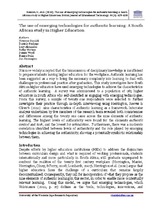| dc.contributor.author | Bozalek, Vivienne | |
| dc.contributor.author | Gachago, Daniela | |
| dc.contributor.author | Alexander, Lucy | |
| dc.contributor.author | Watters, Kathy | |
| dc.contributor.author | Wood, Denise | |
| dc.contributor.author | Ivala, Eunice | |
| dc.contributor.author | Herrington, Jan | |
| dc.date.accessioned | 2014-08-04T07:39:18Z | |
| dc.date.available | 2014-08-04T07:39:18Z | |
| dc.date.issued | 2013 | |
| dc.identifier.citation | Bozalek, V., Gachago, D., Alexander, L., Watters, K., Wood, D., Ivala, E. & Herrington, J. (2013) The use of emerging technologies for authentic learning: A South African study in Higher Education, British Journal of Educational Technology, 44(4): 629-638 | en_US |
| dc.identifier.issn | 0007-1013 | |
| dc.identifier.uri | http://hdl.handle.net/10566/1147 | |
| dc.description.abstract | It is now widely accepted that the transmission of disciplinary knowledge is insufficient
to prepare students leaving higher education for the workplace. Authentic learning has
been suggested as a way to bring the necessary complexity into learning to deal with
challenges in professional practice after graduation. This study investigates how South
African higher educators have used emerging technologies to achieve the characteristics
of authentic learning. A survey was administered to a population of 265 higher educators
in South Africa who self-identified as engaging with emerging technologies. From
this survey, a sample of 21 respondentswere selected to further investigate their practice
through in-depth interviewing using Herrington, Reeves and Oliver’s nine characteristics
of authentic learning as a framework. Interrater analysis undertaken by five
members of the research team revealed both consistencies and differences among the
twenty one cases across the nine elements of authentic learning. The highest levels of
authenticity were found for the elements authentic context and task, and the lowest for
articulation. Furthermore, there was a moderate correlation identified between levels of
authenticity and the role played by emerging technologies in achieving the authenticity,
showing a potentially symbiotic relationship between them. | en_US |
| dc.language.iso | en | en_US |
| dc.publisher | Wiley-Blackwell | en_US |
| dc.rights | This is the authors' final draft following peer review. It may be displayed and circulated, subject to full acknowledgement of authors and source. The published item is copyright Wiley-Blackwell. | |
| dc.source.uri | http://dx.doi.org/10.1111/bjet.12046 | |
| dc.subject | Authentic learning | en_US |
| dc.subject | Emerging technologies | en_US |
| dc.subject | South Africa | en_US |
| dc.subject | Higher education | en_US |
| dc.title | The use of emerging technologies for authentic learning: A South African study in higher education | en_US |
| dc.type | Article | en_US |
| dc.privacy.showsubmitter | false | |
| dc.status.ispeerreviewed | true | |
| dc.description.accreditation | Web of Science | en_US |

